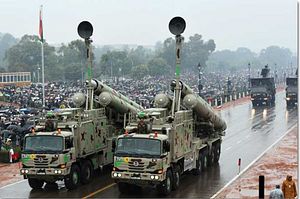For the second time in just over 24 hours, the Indian Ministry of Defense’s (MoD) research arm, the Defense Research Development Organization (DRDO), and the Indian Army have test fired a supersonic BrahMos cruise missile. The latest test occurred on May 22 and was fired from an autonomous mobile launcher, the Indian Ministry of Defense (MoD) said in a statement.
The launch took place at 11:45 a.m. local time at a test range in Balasore district in the eastern Indian state of Odisha and “fulfilled its objectives,” the MoD said. The launch tested new locally designed components of the BrahMos developed for some of the missile’s subsystems to extend its service life from 10 to 15 years.
“Through this launch the critical indigenous components including fuel management system and other non-metallic airframe components have qualified to form part of the missile,” Sudhir Mishra, the head of BrahMos Aerospace — the Indian Russian joint venture responsible for the design, development, and production of the supersonic missile — said earlier today.
India has made a concerted effort over the last few years to incrementally indigenize the various components and subsystems of the BrahMos missile, a joint venture between India’s DRDO and Russian rocket design bureau NPO Mashinostroyeniya, amid a souring of India-Russia defense relations and the cancellation of a number of joint defense projects.
In March, a ground-launched BrahMos equipped with an indigenous seeker — developed by BrahMos Aerospace and DRDO, and manufactured by state-owned Electronics Corporation of India — was successfully tested for the first time. Russia still supplies the missile’s ramjet propulsion system and seeker technology (for now), while India provides the inertial navigation system and fire control system.
Indian defense contractor Larsen & Toubro has also developed a Quadruple Canisterised Inclined Launcher (QCIL) for the BrahMos missile to be installed on Indian Navy warships. The company presented the QCIL prototype earlier in early May. Sudhir Mishra said earlier this month that 85 percent of the components of the BrahMos missile will soon be made in India.
DRDO is also slated to test an indigenous missile booster for the BrahMos next month.
The two-stage BrahMos missile — named after the Brahmaputra River in India and the Moskva River in Russia – is a derivative of the Russian P-800 Oniks over-the-horizon supersonic anti-ship cruise missile. The land-launched and sea-launched variants of the BrahMos are already in service with the Indian Army and Navy. An air-launched variant is expected to become operational by the end of 2018 with the Indian Air Force.
The last test of the missile took place earlier this week at the at the Integrated Test Range in Chandipur along the coast of Odisha. “The successful test will result in huge savings of replacement cost of missiles held in the inventory of Indian Armed Forces,” the Indian minister of defense, Nirmala Sitharaman, tweeted on May 21 in response to the successful test.

































